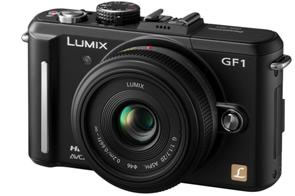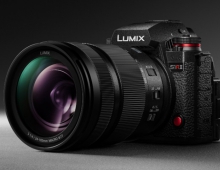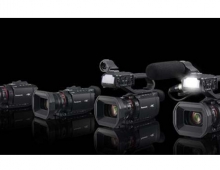
Panasonic Introduces The LUMIX DMC-GF1 Digital Camera
Today, Panasonic announced the new LUMIX DMC-GF1, the latest addition to the LUMIX G Series, which debuts as the world?s smallest and lightest system digital camera with a built-in flash.
The LUMIX DMC-GF1 distinguishes itself from previous models with its elegant, compact design reminiscent of classic film cameras, yet builds on Panasonic's success with the LUMIX G Series of digital interchangeable lens system cameras based on the Micro Four Thirds system standard.
Like its predecessors in the LUMIX G Series, the LUMIX GF1 eliminates the pentaprism found in traditional interchangeable lens cameras. Thus, this mirror-free structure allows Panasonic to reduce both size and weight. The LUMIX GF1 optimizes the advantages of a system camera to ensure high performance, whether capturing photos or HD video. The LUMIX DMC-GF1 can record 1280 x 720 High Definition video in AVCHD Lite, a format that enables longer recording times. With a dedicated video record button, capturing video is easy. The LUMIX GF1 can also record HD Motion JPEG in 1280 x 720 and other video recording formats include: QVGA, VGA and WVGA. The LUMIX GF1 has a Movie Program Mode that allows consumers to adjust the depth-of-field while shooting in HD video, so background and foreground can be blurred to give creative effects ? something typically only possible with expensive professional camcorders.

The LUMIX DMC-GF1 includes the new My Color mode, which includes seven preset effects - Expressive, Retro, Pure, Elegant, Monochrome, Dynamic Art, Silhouette and Custom - all which let users manually set the color, brightness and saturation levels. With the Live View function, users can see how these settings will effect the photo before they shoot, making it easier to capture the exact mood or atmosphere desired. For even more elaborate effects, users can choose from a total of nine Film modes, and set the contrast, sharpness and saturation levels for each. A custom function lets users store their favorite settings in memory. Furthermore, the exposure meter can be displayed in other shooting modes and the correlation between shutter speed and aperture is shown, with a color-coded warning that alerts users when the settings are not in the proper range.
For those users not quite comfortable with extensive manual and creative controls, the LUMIX GF1 provides a user-friendly setting that can address a beginner's comfort level, while helping them evolve their photography skills.
Also, helping to make the LUMIX GF1 more approachable, Panasonic?s popular iA (Intelligent Auto) mode, a system of technologies that engage automatically - no setting changes needed ? allows for intuitive use when shooting still or video images. While shooting video, iA activates Panasonic's O.I.S. (Optical Image Stabilization), which helps reduce video-blurring due to handshake. In addition, Face Detection automatically detects a face in the frame and adjusts focus, exposure, contrast, and skin complexion on it so it always turns out beautifully. Intelligent Exposure continually checks the ambient light level and adjusts the exposure setting as conditions change to prevent blown highlights and blocked shadows. For still photos, the iA system encompasses: Face Recognition (up to six faces can be registered); Auto Focus (AF) Tracking; Mega O.I.S.; Intelligent ISO; Intelligent Exposure; and Intelligent Scene Selector.
The LUMIX GF1 also comes equipped with a built-in flash and a 3.0-inch Intelligent LCD with a wide viewing angle and a 460,000-dot resolution. The Intelligent LCD offers automatic backlight control, which when combined with its high-resolution, helps improve visibility in all light environments - from sunny outdoors to low-light interior settings. New for the LUMIX G Series, the LUMIX GF1 is compatible with an optional Live View Finder (DMW-LVF1), which provides the full-time live view function boasting 100% field of view regardless of the attached lens. To further expand the LUMIX G Series system, Panasonic Micro Four Thirds digital cameras can be used with Four Thirds System interchangeable lenses via an optional mount adaptor DMW-MA1 and with the prestigious Leica M/R lenses using Panasonic's DMW-MA2M DMW-MA3R. These adapters give the user access to the unlimited number of lens properties.
The LUMIX GF1's sensor technology offers the best of both worlds - high image quality of a CCD sensor, and the low-power consumption of a CMOS sensor. Advanced technology makes it possible to read four channels of data simultaneously, helping the LUMIX GF1 deliver 60 frames-per-second full-time Live View images, while maintaining fine detail and rich gradation. The LUMIX GF1's Venus Engine HD records stunning high-resolution 12-megapixel images using its advanced Live MOS Sensor. This LSI circuit separates chromatic noise from luminance noise and applies the optimal noise reduction to each, helping to capture clear and beautiful images even when shooting at high ISO levels.
The contrast AF system adopted in the LUMIX GF1 is not only accurate, but also very quick - approximately 0.3 seconds with the LUMIX G H-FS014045 lens. Users can choose from a wide-range of AF modes, including multiple-area AF with up to 23 focus areas; 1-area AF with a selectable focus area; Face Detection; and AF Tracking. The LUMIX GF1 also has a Quick AF function that begins focusing as soon as the user aims the camera - without pressing the shutter button halfway.
As with all Panasonic LUMIX G Series digital cameras, the LUMIX GF1 is equipped with a highly-effective Dust Reduction system. Thus, if dust gets inside the camera (when changing lenses), Panasonic's Dust Reduction system addresses this problem by placing a supersonic wave filter in front of the Live MOS sensor which vertically vibrates around 50,000 times per second, thus repelling the dust.
The content captured on the LUMIX GF1 can easily be viewed on an HDTV by simply inserting the SD/SDCH Memory Card into the VIERA?s SD/SDHC Memory Card slot. Alternatively, an optional mini HDMI cable can be used to output still and motion images recorded with the LUMIX DMC-GF1 directly to the TV for easy VIERA Link operation, with control of playback functions, such as slideshows, managed from the VIERA HDTVs remote control.
The Panasonic LUMIX DMC-GF1 will be available in early October 2009 with the option of two kits - both with a suggested retail price (SRP) of $899.95. One kit option includes the newly-announced LUMIX G 20mm/F1.7 ASPH, a compact and lightweight "pancake" lens, while the other kit features the LUMIX G VARIO 14-45mm/F3.5-5.6 ASPH/MEGA O.I.S. The optional Live View Finder DMW-LVF1 has an SRP of $199.95; while the DMW-MA2M and DMW-MA3R both have an SRP of $249.95. All new accessories will also be available in early October.
New Interchangable Lenses
Panasonic also introduced two new Micro Four Thirds digital interchangeable lenses - the LUMIX G 20mm/F1.7 ASPH, a compact and lightweight "pancake" lens with outstanding brightness, and the world?s first Leica Micro Four Thirds lens, the LEICA DG MACRO-ELMARIT 45mm/F2.8 ASPH/MEGA O.I.S. Both lenses are compatible with Panasonic?s LUMIX G Series Micro Four Thirds standard digital cameras, which include the LUMIX DMC-G1 and LUMIX DMC-GH1 models; and the LUMIX DMC-GF1, also introduced today.
The LUMIX G 20mm/F1.7 ASPH lens features a F1.7 brightness. Comprised of seven lenses arranged in five groups, the LUMIX G 20mm lens actually uses two aspherical lenses to minimize distortion and achieve super high resolution. The 20mm focal length (equivalent to 40mm on a 35mm film camera) is suitable for all applications - from scenery shots to dimly-lit indoor environments.
The second lens added to the line, the LEICA DG MACRO-ELMARIT 45mm/F2.8 ASPH/MEGA O.I.S. (equivalent to 90mm on a 35mm film camera), features high image quality that meets the renowned LEICA standard. The new Leica lens uses both an aspherical lens and an ED lens comprised of fourteen lenses arranged in ten groups. This lens takes advantage of the Micro Four Thirds specifications to achieve a dramatic size decrease, while also minimizing distortion and glare. Panasonic's Mega Optical Image Stabilizer (O.I.S.) suppresses the blurring that is commonly caused by hand-shake.
The LEICA DG MACRO-ELMARIT 45mm/F2.8 ASPH/MEGA O.I.S. lens incorporates an inner focus motor system that makes action smooth and silent when capturing still and video content. By flipping a switch on the lens barrel, the minimum focus distance can instantly be changed to 150mm or 500mm (approximately 5.9 inches or 19.7 inches respectively). This lens excels when taking portraits, mid-range snapshots and landscapes, in addition to macro shots.
The LUMIX G 20mm/F1.7 ASPH lens will have a suggested retail price (SRP) of $399.95 and the LEICA DG MACRO-ELMARIT 45mm/F2.8 ASPH/MEGA O.I.S. lens will have an SRP of $899.95. Both lenses will be available in early October 2009.
Like its predecessors in the LUMIX G Series, the LUMIX GF1 eliminates the pentaprism found in traditional interchangeable lens cameras. Thus, this mirror-free structure allows Panasonic to reduce both size and weight. The LUMIX GF1 optimizes the advantages of a system camera to ensure high performance, whether capturing photos or HD video. The LUMIX DMC-GF1 can record 1280 x 720 High Definition video in AVCHD Lite, a format that enables longer recording times. With a dedicated video record button, capturing video is easy. The LUMIX GF1 can also record HD Motion JPEG in 1280 x 720 and other video recording formats include: QVGA, VGA and WVGA. The LUMIX GF1 has a Movie Program Mode that allows consumers to adjust the depth-of-field while shooting in HD video, so background and foreground can be blurred to give creative effects ? something typically only possible with expensive professional camcorders.

The LUMIX DMC-GF1 includes the new My Color mode, which includes seven preset effects - Expressive, Retro, Pure, Elegant, Monochrome, Dynamic Art, Silhouette and Custom - all which let users manually set the color, brightness and saturation levels. With the Live View function, users can see how these settings will effect the photo before they shoot, making it easier to capture the exact mood or atmosphere desired. For even more elaborate effects, users can choose from a total of nine Film modes, and set the contrast, sharpness and saturation levels for each. A custom function lets users store their favorite settings in memory. Furthermore, the exposure meter can be displayed in other shooting modes and the correlation between shutter speed and aperture is shown, with a color-coded warning that alerts users when the settings are not in the proper range.
For those users not quite comfortable with extensive manual and creative controls, the LUMIX GF1 provides a user-friendly setting that can address a beginner's comfort level, while helping them evolve their photography skills.
Also, helping to make the LUMIX GF1 more approachable, Panasonic?s popular iA (Intelligent Auto) mode, a system of technologies that engage automatically - no setting changes needed ? allows for intuitive use when shooting still or video images. While shooting video, iA activates Panasonic's O.I.S. (Optical Image Stabilization), which helps reduce video-blurring due to handshake. In addition, Face Detection automatically detects a face in the frame and adjusts focus, exposure, contrast, and skin complexion on it so it always turns out beautifully. Intelligent Exposure continually checks the ambient light level and adjusts the exposure setting as conditions change to prevent blown highlights and blocked shadows. For still photos, the iA system encompasses: Face Recognition (up to six faces can be registered); Auto Focus (AF) Tracking; Mega O.I.S.; Intelligent ISO; Intelligent Exposure; and Intelligent Scene Selector.
The LUMIX GF1 also comes equipped with a built-in flash and a 3.0-inch Intelligent LCD with a wide viewing angle and a 460,000-dot resolution. The Intelligent LCD offers automatic backlight control, which when combined with its high-resolution, helps improve visibility in all light environments - from sunny outdoors to low-light interior settings. New for the LUMIX G Series, the LUMIX GF1 is compatible with an optional Live View Finder (DMW-LVF1), which provides the full-time live view function boasting 100% field of view regardless of the attached lens. To further expand the LUMIX G Series system, Panasonic Micro Four Thirds digital cameras can be used with Four Thirds System interchangeable lenses via an optional mount adaptor DMW-MA1 and with the prestigious Leica M/R lenses using Panasonic's DMW-MA2M DMW-MA3R. These adapters give the user access to the unlimited number of lens properties.
The LUMIX GF1's sensor technology offers the best of both worlds - high image quality of a CCD sensor, and the low-power consumption of a CMOS sensor. Advanced technology makes it possible to read four channels of data simultaneously, helping the LUMIX GF1 deliver 60 frames-per-second full-time Live View images, while maintaining fine detail and rich gradation. The LUMIX GF1's Venus Engine HD records stunning high-resolution 12-megapixel images using its advanced Live MOS Sensor. This LSI circuit separates chromatic noise from luminance noise and applies the optimal noise reduction to each, helping to capture clear and beautiful images even when shooting at high ISO levels.
The contrast AF system adopted in the LUMIX GF1 is not only accurate, but also very quick - approximately 0.3 seconds with the LUMIX G H-FS014045 lens. Users can choose from a wide-range of AF modes, including multiple-area AF with up to 23 focus areas; 1-area AF with a selectable focus area; Face Detection; and AF Tracking. The LUMIX GF1 also has a Quick AF function that begins focusing as soon as the user aims the camera - without pressing the shutter button halfway.
As with all Panasonic LUMIX G Series digital cameras, the LUMIX GF1 is equipped with a highly-effective Dust Reduction system. Thus, if dust gets inside the camera (when changing lenses), Panasonic's Dust Reduction system addresses this problem by placing a supersonic wave filter in front of the Live MOS sensor which vertically vibrates around 50,000 times per second, thus repelling the dust.
The content captured on the LUMIX GF1 can easily be viewed on an HDTV by simply inserting the SD/SDCH Memory Card into the VIERA?s SD/SDHC Memory Card slot. Alternatively, an optional mini HDMI cable can be used to output still and motion images recorded with the LUMIX DMC-GF1 directly to the TV for easy VIERA Link operation, with control of playback functions, such as slideshows, managed from the VIERA HDTVs remote control.
The Panasonic LUMIX DMC-GF1 will be available in early October 2009 with the option of two kits - both with a suggested retail price (SRP) of $899.95. One kit option includes the newly-announced LUMIX G 20mm/F1.7 ASPH, a compact and lightweight "pancake" lens, while the other kit features the LUMIX G VARIO 14-45mm/F3.5-5.6 ASPH/MEGA O.I.S. The optional Live View Finder DMW-LVF1 has an SRP of $199.95; while the DMW-MA2M and DMW-MA3R both have an SRP of $249.95. All new accessories will also be available in early October.
New Interchangable Lenses
Panasonic also introduced two new Micro Four Thirds digital interchangeable lenses - the LUMIX G 20mm/F1.7 ASPH, a compact and lightweight "pancake" lens with outstanding brightness, and the world?s first Leica Micro Four Thirds lens, the LEICA DG MACRO-ELMARIT 45mm/F2.8 ASPH/MEGA O.I.S. Both lenses are compatible with Panasonic?s LUMIX G Series Micro Four Thirds standard digital cameras, which include the LUMIX DMC-G1 and LUMIX DMC-GH1 models; and the LUMIX DMC-GF1, also introduced today.
The LUMIX G 20mm/F1.7 ASPH lens features a F1.7 brightness. Comprised of seven lenses arranged in five groups, the LUMIX G 20mm lens actually uses two aspherical lenses to minimize distortion and achieve super high resolution. The 20mm focal length (equivalent to 40mm on a 35mm film camera) is suitable for all applications - from scenery shots to dimly-lit indoor environments.
The second lens added to the line, the LEICA DG MACRO-ELMARIT 45mm/F2.8 ASPH/MEGA O.I.S. (equivalent to 90mm on a 35mm film camera), features high image quality that meets the renowned LEICA standard. The new Leica lens uses both an aspherical lens and an ED lens comprised of fourteen lenses arranged in ten groups. This lens takes advantage of the Micro Four Thirds specifications to achieve a dramatic size decrease, while also minimizing distortion and glare. Panasonic's Mega Optical Image Stabilizer (O.I.S.) suppresses the blurring that is commonly caused by hand-shake.
The LEICA DG MACRO-ELMARIT 45mm/F2.8 ASPH/MEGA O.I.S. lens incorporates an inner focus motor system that makes action smooth and silent when capturing still and video content. By flipping a switch on the lens barrel, the minimum focus distance can instantly be changed to 150mm or 500mm (approximately 5.9 inches or 19.7 inches respectively). This lens excels when taking portraits, mid-range snapshots and landscapes, in addition to macro shots.
The LUMIX G 20mm/F1.7 ASPH lens will have a suggested retail price (SRP) of $399.95 and the LEICA DG MACRO-ELMARIT 45mm/F2.8 ASPH/MEGA O.I.S. lens will have an SRP of $899.95. Both lenses will be available in early October 2009.





















